32. The anatomy, histology and development of the uterine tube and uterus.
Anatomy of Uterus/Uterine Tube
Uterus:
Location: b/w bladder (ant) and rectum (post), above and leads to vagina
Function: Major organ of gestation
General Info:
7-8 cm long, 5-7 cm wide, 2-3 cm wide
2 main parts = corpus (upper 2/3) and cervix (lower 1/3) , connected via isthmus
- Cervix protrudes into vagina @ angle of 60-70 degress = anteversion ( angle b/w vagina and cervical canal)
- Body inclines forward and bends over fundus of bladder, attached to cervix w/ angle of another 60 degrees = anteflexion ( angle b/w jxn of cervix and body)
Topography:
- ant = fundus of bladder
- post = coils of SI, and via pouch of Douglas, the rectum
- lat = cardinal ligament @ level of cervix (part of parametrium), that carries the uterine a/v
- sup = fundus of uterus touches SI coils
- inf = supported by pelvic diaphragm, UG diaphragm, round, broad, lateral cervical ligaments, pubovesical, sacrocervical, retro-uterine ligaments
Parts:
Cervical portion:
has 2 areas:
Vaginal portion – protrudes into vagina,surrounded by vaginal fornices
- has rounded end and ext os of uterine canal w/in it
- @ ext os, simple columnar epith –> str squamous
- If no kids (nulliparous) – opening is round, and small
- If kids (multiparous) – opening is slit like
Supravaginal portion – embedded into CT of visceral pelvic fascia (via parametrium), in direct contact w/ broad ligament (myometrium)
Cervical Canal:
- terminal portion of uterine cavity
- has impermeable plug of mucus,
- helps prevent entrance of pathogens
- that becomes permeable during ovulation –
- does allow sperm to penetrate
- helps prevent entrance of pathogens
- b/w cervix and isthmus of uterus = int histological os – where wall of cervix changes to uterus histologically
Epith of cervix isn’t shed in menstruation like the epith of rest of uterus = simple columnar, # of glands inc in this area – they secret the mucus to make mucus plug
keeps closed until few hours before birth – then begins to dilate to allow head thru – this is due to high amt of collagen and smooth M in cervix
Cervix doesn’t have real myometrium, called it, but really has less smooth m and more elastic fibers compared to rest of uterus
NOTE: (Please do not be confused by the 50 names out there for the same thing)
- Int opening of isthmic canal = anatomical int os (does not exist in pregnancy)
- Int opening of uterus = int os = histological int os = external opening of isthmus (isthmic canal)
- Ext opening of uterus = external os
Corpus
Biggest part of uterus
covered by broad ligament = called the mesometrium of uterus, attaches it to lateral body wall
bends over the bladder (ant)
Has two special parts : fundus & isthmus
Fundus
- area above the level of uterine tubes
- laterally, ends in uterine horns –> lead to uterine tube
Isthmus
- narrow part locared b/w cervix & corpus of uterus
- same histological structures as corpus of uterus
- incorporated into cavity of uterus during pregnancy – @ 2nd 1/2 of pregnancy, isthmus opens up, so anat int os ceases to exist, only histo os and ext os still there
- isthmic canal – canal w/in the isthmus
- Int anatomical os – b/w isthmic canal and uterine cavity
Wall of Uterus
Perimetrium = outer layer, peritoneum & underlying subserosa
Myometrium = middle musc layer, has sublayers
Endometrium = innermost layer, layer removed during menstruation
Ligaments of Female Pelvis
- Broad ligament of uterus – 2 layers of peritoneal covering, from lat margin of uterus –> lat pelvic wall
- holds uterus in position
- contains: uterine tube, a/v, round ligament, ovarian ligament proper, urete, uterovaginal n. plexus, lymph vessels
- Mesovarium – fold of peritoneum that connects ant surface of ovary w/ post layer of broad ligament
- Mesosalpinx – fold of broad ligament that suspends the uterine tube
- Mesometrium– fold of broad lig below mesosalpinx, and meso-ovarium, lat wall of uterus –> pelvic wall
- Proper Ovarian ligament – fibromusc cord from uterine end of ovary –> side of uterus below uterine tube w/in broad lig
- Suspensory ligament of ovary – band of peritoneum that runs sup/lat from end of ovary –> pelvic wall, has ovarian a/v, lymph vessels
- Lat/Transverse Cervical (Cardinal) Lig of Uterus (aka ligament of Mackenrodt’s) – fibromuscular condensations of pelvic fascia from cervix (hence, cervical) & lat fornix of vagina –> pelvic wall, run w/in parametrium of uterus
- Parametrium – fibrous CT that runs w/in mesometrium, connects uterus to lat pelvic wall
- Paracolpium – fibrous CT that connects the lat wall of vagina –> lat pelvic wall, fibers merge w/ those of para cysticum (for bladder)
- Pubocervical ligament – firm bands of CT from post surface of pubis –> cervix of uterus
- Sacrocervical(uterine) ligament – firm fibromuscular bands of pelvic fascia from lower end of sacrum –> to cervix, upper end of vagina *palpable in rectal exam
- Pubovesical ligament – pelvic fascia bands from neck of bladder (or prostate in male) –> pelvic bone
- Rectouterine ligament – holds cervis back and up and sometimes elevate a shelf-like fold of pertioneum (recto-uterine folds – called sacro-genital folds in male)
- isthmus of uterus –> post wall of pelvis, lat to rectum
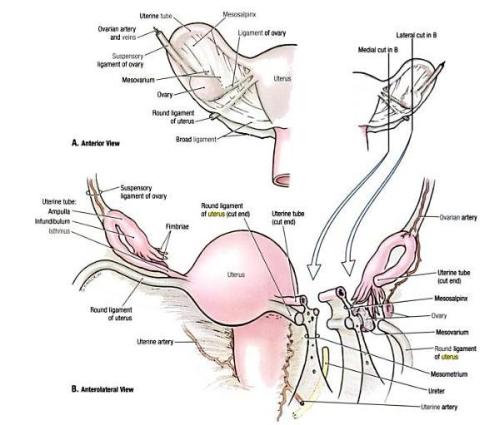
Ligament relations of Uterus & Uterine tube

Connective tissue ligaments of female pelvis
Also, peritoneal covering over pelvic organs in female create 2 pouches:
1. Vesicouterine Pouch
- ant = bladder
- post = uterus
- lat = vesicouterine folds
2. Rectouterine pouch – aka Douglas pouch
- ant = uterus
- post = rectum
- lat = rectouterine folds
- floor = post fornix of vagina, in direct contact w/ ampulla of rectum *can be felt there via rectal exam
CLINICAL NOTE: This is deepest point of peritoneal cavity in female, any excess peritoneal fluid will collect there
blood in pouch can indicate the presence of ectopic pregnancy
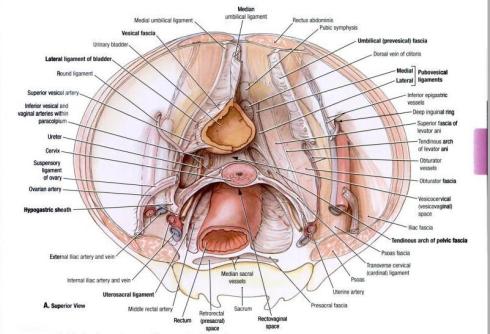
Pouces and ligaments/Topography of Female Pelvis
Blood Supply: primarily uterine a, secondarily ovarian a
- Uterine a enters parametrium via cardinal ligament of ovary
- when it reaches isthmus, divides into large asc uterine br
- small desc uterine br
- also has ovarian and tubal br
- @ cardinal lig – uterine a/v crosses ureter and have vessels in fromt
- Ovarian a
- has ovarian and tubal br that anastomose w/ same br of uterine a
- Veins = uterovaginal plexus of veins –> int/ext iliac v
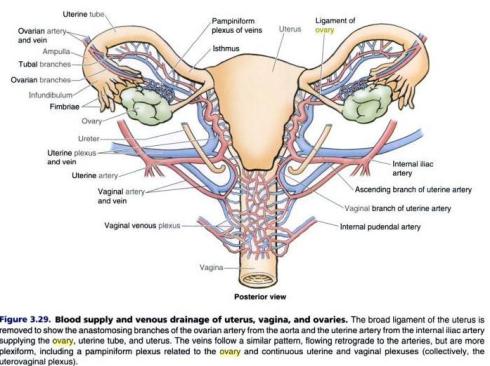
Blood Supply of Uterus, Uterine tube
Lymph Drainage:
1. Fundic region = aortic nodes via ovarian lymph vessels
2. Corpus = ext iliac and sup inguinal nodes
3. Cervix = int iliac and sacral nodes
Nerve Supply = branches of hypogastric n plexus,
Uterine Tube:
non united part of Mullerian duct (embryo)
Location: from horn of uterus –> ends in ampulla @ uterine end of ovaries
Function:
- carries fertilized or unfertilized ovum from ovary to uterus, for Implantation
- via action of the cilia on its epithelium, and contraction of musc wall, also carries sperm towards the ovary
- Connects uterine cavity w/ peritoneal cavity
- Fertilization occurs in ampulla or infundibulum of uterine tube
Parts:
1. Infundibulum – funnel-shaped distal portion over end of ovary
- has 20-30 fimbriae, which attach to ovary
- move to guide oocyte in after ovulation
- communicates w/ peritoneal cavity via abdominal ostium
2. Ambulla – FERTILIZATION
- widest and longest part of uterine tube
- INTRAPERITONEAL
- attached w/in broad ligament via mesosalpinx
3. Isthmus – short 2.5 cm long area that leads to horn of uterus
4. Uterine part
- part that attaches to uterine wall
- opens into uterine cavity via uterine ostium
Blood supply = tubal br of ovarian and uterine a, veins run w/ a
Lymph drainage = run to aortic/lumbar nodes
Nerve supply = pelvic/ovarian n. plexus, that run in mesosalpinx
Minimals related to this topic:

196. Describe the relation of the ovary to the uterine tube!
The upper or tubal end of the ovary is closely related to the uterine tube. The infundibulum has irregular fringes called fimbriae that project from the margin of the infundibulum to the ovary.
197. Define the term “broad ligament of the uterus” and list those structures that are located within its substance!
A double layered peritoneal ligament extending from the sides of the uterus to the lateral walls and the floor of the pelvis.
Structures: uterine tube, round lig. of uterus, ovarian lig., epoophoron, paroophoron, uterine vessels, uterovaginal venous plexus, nerves.
198. Define the term “parametrium”!
The loose connective tissue found between the two diverging layers of the broad ligament of uterus, which connects the lateral part of the cervix with the pelvic wall.
199. Define the position of the uterus under normal conditions?
In the axis of the true pelvic, in anteflexion (bends forward) and anterversion (inclines forward)
200. Define the term anteflexion and anteversion of the uterus!
Anteversion: the cervix is inclined anteriorly at an acute angle (appr. 60°-70°) to the vagina.
Anteflexion: the body of the uterus is bent anteriorly at an acute angle (appr. 60’-70’) to the cervix.
201. Describe visceral relations of the uterus!
anterior : posterior wall of bladder,
posterior : anterior surface of rectum, small intestines,
above : small intestines,
lateral : ureter, before its opening into the urinary bladder.
202. What is the epithelium of the a.) cervical canal and b.) vaginal portion of the uterus?
simple columnar mucous producing epithelium, with scatterd ciliated cells,
stratified squamous non keratinizing epithelium.
203. Describe the peritoneal relations of the uterus!
The body and the posterior aspect of the supravaginal portion of the cervix is enclosed between the two layers of the broad ligament. The peritoneum reflects from the uterus posteriorly to the rectum and anteriorly to the urinary bladder forming the rectouterine and vesicouterine pouches, respectively.
204. Define the term “Douglas pouch”?
Rectouterine pouch. Reflection of the peritoneum from the rectum to the uterus. The deepest point of the peritoneal cavity.
205. List those structures that help to fix the uterus in its original position!
Vagina, pelvic and urogenital diaphragms, round lig., ovarian lig., vesicouterine fold, rectouterine fold, thickenings of the visceral pelvic fascia, broad lig., parametrium.
206. Which lymph nodes receive lymph from the a.) fundus, b.) body and c.) cervix of the uterus?
aortc, external iliac, superficial inguinal lymph nodes,
external iliac lymph nodes,
internal iliac and sacral lymph nodes.
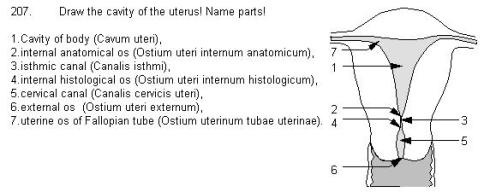
Histology of Uterus/Uterine Tube
Slide #76 Uterus, Proliferative phase
Structures to Identify:
- all layers of wall
- simple columnar lining epithelium
- simple tubular glands
- a/v – arteries have a fused tunica mucosa
- LP w/ spinocellular CT
General Info:
- Endometrium (same as mucosa) changes with menstrual cycle
- Menstrual cycle
- Day 1-5 = Menstruation
- Day 5-6 Regeneration
- Day 6-14 Proliferative/Estrogen phase
- Day 14-28 Secretory/Progesterone/Luteal phase
- Uterus provides the site of implantation of fertilized embryo and formation for placenta
- Note that the embryo grows within the wall of the uterus, causing the lumen to narrow, and forms a separate amniotic sac – the embryo does not grow in uterus lumen per se.
Endometrium
- innermost layer, is equivalent to mucosa in other slides
- changes made in endometrium based on hormones produced by ovaries
- To tell that it is Uterus look for: v THICK mucosa, with loads of glands, and is very basophillic
Epith
- simple columnar epith (ciliated and non ciliated cells)
- epith is lower because this is the start of the cycle
- non-ciliated cells will secret hormones in second part of cycle
LP
- cell rich CT highly vascularized
- simple tubular glands – inactive in this stage
- b/w glands, spinocellular CT & a/v
- the endometrial stroma, which resembles mesenchyme
- is highly cellular+ contains abundant intercellular ground substance.
- cells = stromal cells like in ovary
- the endometrial stroma, which resembles mesenchyme
- thickness depends on stage in cycle
- Has two layers = Statum Functionalis superiorly, and Stratum Basalis inferiorly
- Blood Supply:
- RADIAL ARTERIES, (branches from the arcuate arteries in myometrium), enter the basal layer of the endometrium, where it give off small straight arteries that supply this region of the endometrium.
- The main branches of the radial artery continous upward, become highly coiled SPIRAL ARTERY
- Spiral arteries give off numerous arterioles, that often anastomoses, as they supply a rich capillary bed.
- Lacuna= dilated segmants, may also occur in the venous system, that drains the endometrium.
- The straight arteries+ the proximal part of the spiral arteries do not change during the menstrual circle.
- The distal portion of the spiral ateries undergoes degeneration+ regeneration, with each menstrual cycle, under the influence of estrogen+ progesteron.

Note the smooth and oval glands in the endothelium = def proliferative phase uterus
Stratum Functionalis
- the one that proliferate+ degenerate during menstrual cycle
- during this phase of the menstrual cycle, the endometrium varies from 1 to 6 mm in thickness.
- UTERINE GLANDS(simple tubular): surface epithelium invaginate into the underlying lamina propria, the endometrial stroma.
- containing fewer ciliated cells
- If the glands are oval and smooth in the section, then you know it is proliferative stage.
- Separated into upper Compact Layer, and inner Spongy layer
Stratum Basalis
- minimal changes in the is layer between stages in the uterus
- regeneration of epithelium starts from the stromal cells and glands in this layer
- large amount of cells int his layer – even more so than in basal layer
NO MUSC MUCOSA/ SUBMUCOSA separate the endometrium from the myometrium.
Myometrium

-
is the thickest layer of the uterine wall
-
composed of 3 undefined layers of smooth muscle bundles: you see cross, oblique, longitudinal sections.
-
the smooth muscle bundles in the inner+ outer layers are predominantly oriented parallel to the long axis of the uterus.
- muscle separated by interstitial CT
- lots of a/v. —> tunica media of arteries merges with smooth m of the myometrium
- arcuate a in myometrium = vascular zone
- separates the uteine wall into three zones – Supra vascular, vascular, and perivascular below.
-
6- 10 arcuate arteries coming from the uterine artery that anastomose in the myometrium
Perimetrium
- adventia/serosa
- on sup surface of uterus, covered with peritoneum –> serosa
- In other surfaces of uterus, is infraperitoneal –> covered with adventia
- If adventia, can possibly see ggl cells and nerve cells
PROLIEFERATING PHASE REGULATED BY ESTROGEN:
- at the end of the menstrual phase, the endometrium consits of a thin band of CT(about 1 mm) thick, containing the basal portion of the uterine gland+lower portion of the spiral arteries. = stratum basale the layer, that was sloughed off was the stratum functionale.
- Stromal, endothelial+ epithelial cells in the stratum basale proliferate rapidly, following changes can be seen:
- Epithelial cells in the basal portion of the glands reconstitute the glands & migrate to cover the denuded endometrial surface.
- Stromal cells: proliferate, secrete collagen, & ground substance
- Spiral arteries lenghten, as the endometrium is reestablished, these arteries are only slightly coiled+ do not extend into the upper third of the endometrium.
- Continous until 1 day after ovulation, which occurs at about day 14, of a 28- day cycle.
- At the end of this phase, the endometrium has reached a thickness of about 3 mm.
- The glands have narrow lumina+ relatively straight, but have a slightly wavy appearance.
- Accumulation of glycogen are present in the basal portion of the epithelial cells.
Slide #77 Uterus, Secretory phase

See the white space between the cells of stroma? And the twisted glands? = Secretory Phase Uterus
Structures are the same as listed above, with some key differences
Endometrium
- Stratum functionalis –
- MUCH thicker,
- uterine glands are now larger and wavy, not oval shaped –> increase size due to secretion within
- inside of glands are pale because secretions are mostly carbs
- inside of glands are pale because secretions are mostly carbs
- arteries are also more coiled , and become more prominent in this layer
- increase in volume, to prepare for menstruation, the next phase
- increase in volume, to prepare for menstruation, the next phase
- MUCH thicker,
- Stratum basalis –
- less cells in interstitial tissue, more white space between cell
- the increased interstitial fluid between the cells is called Interstitial EDEMA
- more WBC, monocytes, neutrophils, granulocytes
- straight a in this layer —> coiled arteries in fuctional layer
- Stromal cells become decidual cells –> preperation for formation of placenta
Myometrium
- more smooth m fibers
SECRETORY PHASE IS REGULATED BY PROGESTERON
- The stimulation for transformation is the implantation of the blastocyst.
- Large, pale cells rich in glygogen result from this transformation,
- they create a specialized layer that facilitates the seperation of the placenta from the uterine wall at the termination of pregnancy.
Menstrual phase *Dont need to know for test, just theory to understand *
- results from a decline in the ovariation secretion of progesterone+ estrogen
- CORPUS LUTEUM produces hormones for about 10 days if fertilization does not occur.
- As hormone levels rapidly decline, changes occur in the blood supply to the stratum functionale.
- Periodic contractions of the walls of the spiral arteries, lasting for several hours, cause the stratum functionale.
Periodic conctraction of the walls of the spiral arteries, lasting for several hours stratum functionale to become ischemic.
- Glands stop secreting+ the endometrium shrinks in heigh as the stroma becomes less edematous.
- After about 2 days, extended periods of arterial contraction, with only brief periods of blood flow, cause disruption of the surface epithelium+ rupture of the blood vessels.
- When spiral arteries close off, blood flows into the stratum basale, but not in the stratum functionale.
- Blood, uterine fluid+ sloughing stromal+ epithelial cells from the stratum functionale constitute the vaginal discharge.
- As patches of tissue separate from the endometrium, the torn ends of veins, arteries+ glands are exposed.
- In the absence of fertilization, cessation of bleeding would accompany the growth+ maturation of new ovarian follicels.
- The epithelial cells would rapidly proliferate+ migrate to restore the surface epithelium as the proliferative phase of the next cycle begins.
- In the absence of ovulation( a cycle refered to as an anovulatory cycle), a corpus luteum does not form, and progesterone is not produced.
- In the absence of progesterone, the endometrium does not enter the secretory phase until menstruation.
Slide #76 Uterus, Pregnant * H&E
Structures to Identify
- endometrium with glands = decidua basalis
- myometrium
- chroion frondosum (primary villi)
- embryonic cavity
- primary, secondary, tertiary villi
- chorion leave
- decidua capsularis, marginalis, parietalis
- a/v
General Info: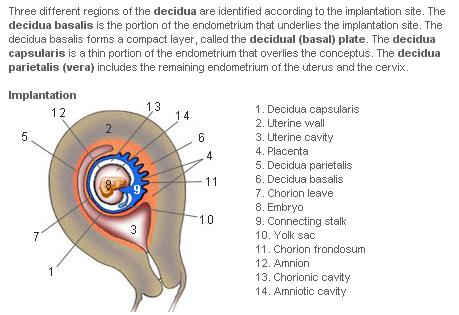
This slide is not as difficult as it may seem. Look at the picture to the right to first familairize yourself with the layers listed.
First look for a long white tube with a thick wavy over covering –> this is the embryonic (amniotic) cavity.
- On one side of it is chorion frondosum, with all the villi inside
- Villi contain fetal blood
- between the villi is the intervillus space that houses maternal blood
- lateral to the chorion frondosum, is decidua basalis
- on the other side of the amniotic cavity, is the chorion laeve, with the decidua capsularis lateral to that.
Villi
- Villi are projections from the decidua that house branches of the uterine a/v, and contain fetal blood
- they project into the space between the decidual layers.
- maternal blood surrounds them in intervillous space
- Free gas exchange occurs between the villi and intervillous space
- 2 types of villi: anchoring villi (attached to chorion), floating villi (free floating)
-
made from trophoblast cells – which makes two layers of cells – syncytiotrophoblast (outer) & cytotrophoblast (inner)
- Primary villus
- 2 layers of trophoblast cells only
- Secondary villus
- 2 layers with extra embryonic mesoderm in w/in
- light center – look for white space in center
- may have small a/b near the center
- Tertiary villus
- the largest ones
- only syncytiotrophoblast layer, much bigger, with a/v near periphery
Slide #74 Uterine Tube * H&E

Labyrinth like lumen of Uterine tube
Structures to Identify:
- simple columnar epithelium
- peg cells (right ovulation, might not be there)
- LP
- muscular layer
- a/v
- mesothelium (cells of perimetrium)
- adipocytes
Lumen: very labyrinth like – looks like a fern
- protrusion into lumens from mucosa
- amt of labyrinth depends on location where section was taken –> less in infudibulum, more closer to uterus
- Do NOT confuse with Prostate. The folds look similar, but there are no prostatic calcifications, and there is only one lumen here, not a bunch of small fuzzy tubules

- Epith and LP of Uterine Tube, with ciliated and peg cells shown
Epith
- simple columnar epithelium – do NOT say psuedo stratified
- some cells ciliated
- these are shorter and have less cilia at times,
- After ovulation , are taller with more cilia,
- depending on hormones released in ovarian cycle (estrogen)
- thickness changes w/ menstrual cycle
- the non ciliated cells = peg cells
- secrete mucin = carbs for sperm
- expelled from epith when dead (die after excreting their mucin)
- project into lumen
- look like nails
- look for long cells in a bump on top of epith
- secrete mucin = carbs for sperm
- During proliferative phase of uterus, with increase amount of estrogen, the cilated cells become larger and have more ciliae – peg cells secret more mucin
L.P.
- loose CT, with a/v
- numerous fibroblasts with collagen and reticular fiber
- supports the CT papilla projections into the mucosa
No Musc. mucosae or Submucosa
Muscular coat (Musc ext)
- inner ciruclar, outer longitudinal layers
- more developed closer to uterus
- has PNS ggl/nfibers – may be able to find them
Outer coat = serosa
- made of double layer of broad ligament with a/v inside
- made of mesothelial cells
- has a/v + adipocytes
Embrology of Uterus/Uterine Tube
-
PARAMESONEPHRIC DUCTS develop into the MAIN GENITAL DUCTS OF THE FEMALE.
-
3 parts can be recognized in each duct:
-
a cranial vertical portion that opens into the abdominal cavity
-
a horizontal part that crosses the mesonephric duct
-
a caudal vertical part that fuses with its partner from the opposite side.
-
-
With descent of the ovary, the first 2 parts develop into the uterine tube+ the caudal parts fuse, to form the uterine canal.
-
When the second part of the paramesonephric ducts moves mediocaudally, the urogenital ridges gradually come to lie in a transverse plane.
-
DUCTS fuse in the midline, a broad transverse pelvic fold is established.
-
BROAD LIGAMENT OF THE UTERUS: fold, which extends from the lateral sides of the fused paramesonephric ducts toward the wall of the pelvis.
-
The uterine tube lies in its upper border, and the ovary lies on its post. Surface.
-
UTERORECTAL POUCH+ UTEROVESICAL POUCH are devided by the uterus+ broad ligaments
-
CORPUS+ CERVIX of the uterus coming from the fused paramesonephric ducts.
-
MYOMETRIUM(= muscular coat of the uterus)+ Peritoneal covering(perimetrium) = layer of mesenchyme
![Reblog this post [with Zemanta]](https://i0.wp.com/img.zemanta.com/reblog_e.png)
